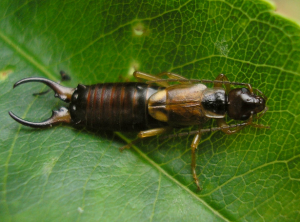 When it comes to common pests in home gardens, earwigs are ranked as the most common. According to pest control professionals, these creatures have the ability to completely devastate small vegetables, soft fruits, corn silks, and annual flowers; however, the insects are also considered to be quite beneficial when it comes to eliminating aphids and the landscape environment, as a whole. There are several unique species of earwigs that are currently in existence; however, the most common is the European earwig. The introduction of this species to the United States was accidental and happened in the early part of the 1900s. In this pest control guide, you will learn several important facts about earwigs and how to control the insects.
When it comes to common pests in home gardens, earwigs are ranked as the most common. According to pest control professionals, these creatures have the ability to completely devastate small vegetables, soft fruits, corn silks, and annual flowers; however, the insects are also considered to be quite beneficial when it comes to eliminating aphids and the landscape environment, as a whole. There are several unique species of earwigs that are currently in existence; however, the most common is the European earwig. The introduction of this species to the United States was accidental and happened in the early part of the 1900s. In this pest control guide, you will learn several important facts about earwigs and how to control the insects.
Physical Characteristics
Earwigs are most recognized by the pair of appendages located on the tail of the body that resemble forceps. Males have curved forceps and females have straight forceps. These are used for defense. The average adult measures approximately ¾ of an inch long. The body of the insect is typically a type of reddish brown. Adult earwigs have wings, which are protected by a hard covering; however, earwigs do not commonly fly. The young earwigs look just like a smaller version of the adult earwigs, but, without the wings. There are many rumors and superstitions regarding earwigs and the attack of humans. Most of these are completely false. It should be known, though, that if earwigs become trapped or feel threatened, they do have the ability to bite a human.
Pest Control Management Techniques
If you have earwigs in or around your home, you must understand that proper pest control management techniques must take full advantage of the insects’ natural habitat in order to be successful. First and foremost, these insects absolutely love regions that contain a lot of moisture and areas where they may easily conceal themselves. The very first step to managing earwigs is to identify all of the locations around your home where the insects may be nesting and open those areas up. Not only will you expose their hiding spots, but, the exposure will allow the sun to hit the regions and drastically reduce the amount of moisture that is present.
Once you have discovered their hiding spots and have started to reduce the moisture in and around those areas, you will observe a huge decrease in the population of the insects. Next, you may create traps for the insects. Simply use an old tuna can and put a little oil on the bottom. Once you capture a large amount, you may dispose of the remains and place new oil in the same can in order to catch more. Insecticides may also be used to control earwig populations. The utilization of insecticides carries many potential dangers. In order to avoid these complications, you should enlist the help of a professional pest control company to help eliminate infestations of earwigs. For more information, contact us here at All Pest Exterminating, Inc. by calling: 765-259-0043
